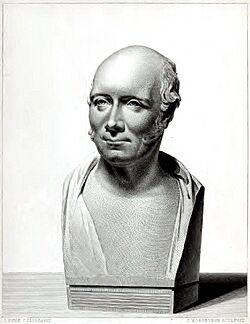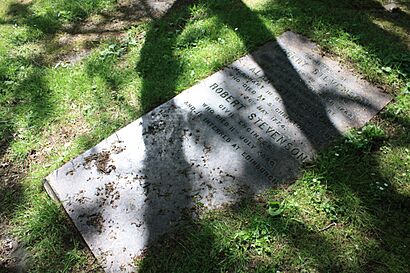Robert Stevenson (civil engineer) facts for kids
Quick facts for kids
Robert Stevenson
|
|
|---|---|

Bust of Stevenson by Samuel Joseph, commissioned 19 July 1824 by the Northern Lighthouse Board.
Illustration from the Biographical Sketch of the Late Robert Stevenson: Civil Engineer by his son Alan Stevenson, 1851 |
|
| Born | 8 June 1772 Glasgow, Scotland
|
| Died | 12 July 1850 (aged 78) Edinburgh, Scotland
|
| Resting place | New Calton Cemetery, Edinburgh |
| Nationality | Scottish |
| Education | Andersonian Institute University of Edinburgh |
| Occupation | Civil engineer |
| Spouse(s) | Jean Smith |
| Children | Alan, David and Thomas |
| Engineering career | |
| Discipline | Civil engineer |
| Institutions | Royal Society of Edinburgh Geological Society Royal Astronomical Society Society of Antiquaries of Scotland Wernerian Society Institution of Civil Engineers |
| Employer(s) | Northern Lighthouse Board |
| Projects | Bell Rock Lighthouse |
| Significant design | Lighthouses |
Robert Stevenson (born June 8, 1772 – died July 12, 1850) was a famous Scottish civil engineer. He was best known for designing and building many lighthouses. One of his most important projects was the Bell Rock Lighthouse. He also helped build roads, bridges, and canals.
Contents
Early Life and Family
Robert Stevenson was born in Glasgow, Scotland. His father, Alan Stevenson, passed away when Robert was almost two years old. This left his mother, Jean Lillie Stevenson, with less money. Because of this, Robert went to a special school for children from families with less money.
Robert's mother hoped he would become a minister. So, when he was older, she sent him to a school to study languages. But when Robert was 15, his mother got married again. The family then moved to Edinburgh. Robert's new stepfather was Thomas Smith. He was a clever inventor and an engineer who worked for the Northern Lighthouse Board. This board was in charge of building and maintaining lighthouses in Scotland.
Robert learned a lot from his stepfather. Later, Robert took over his stepfather's house in Edinburgh.
Becoming an Engineer
Robert worked as an apprentice engineer for his stepfather. He was very good at it. By age 19, he was in charge of building a lighthouse on Little Cumbrae island. After that, he supervised lighthouses in Orkney. While working, he also studied surveying and drawing. He attended classes in math and physics at the Andersonian Institute in Glasgow.
During the cold winter months, when construction stopped, he went to the University of Edinburgh. He studied philosophy, math, chemistry, and other subjects. He didn't get a degree because he didn't know Latin or Greek, which was required back then.
In 1797, Robert became the chief engineer for the Lighthouse Board. He took over from his stepfather. In 1799, he married Jean, his stepsister and Thomas Smith's oldest daughter. In 1800, Smith made Robert his business partner.
Building the Bell Rock Lighthouse
Robert Stevenson's most famous work was the Bell Rock Lighthouse. This lighthouse was built between 1807 and 1810. It still stands today! Building it was a huge and dangerous project. The lighthouse was based on an older design, but Robert made many improvements.
There was some debate about who deserved more credit for the Bell Rock Lighthouse: Robert Stevenson or another engineer named John Rennie. However, the Northern Lighthouse Board and later historians gave full credit to Robert Stevenson.
Dangers and Innovations
Robert often faced dangerous situations during his work. Once, his boat was caught in a storm, but he was lucky to get off before it sank. Another time, he and his crew were stuck on the Bell Rock at low tide. Their boat drifted away, and there wasn't enough room in the other boats. Luckily, a pilot boat arrived just in time to save them.
Robert worked for the Northern Lighthouse Board for almost 50 years, until 1842. He designed many lighthouses. He also made them better with new ideas. He improved the light sources and how they were mounted. He also designed better reflectors. He was one of the first to use Fresnel lenses, which made lights much brighter.
He also created systems that made each lighthouse's light unique. This way, sailors could tell which lighthouse they were seeing. For this smart idea, he received a gold medal from the King of the Netherlands.
Other Engineering Projects
After the wars ended, there was a big need to improve roads, bridges, and canals. Robert Stevenson was very busy. Besides lighthouses, he worked on many other projects. He helped build the Hutcheson Bridge in Glasgow and the Regent Bridge in Edinburgh. He also designed new bridges and railways that were built later by others.
He invented special cranes to help build lighthouses. He also helped change how railways were built, using stronger iron rails. In 2016, he was added to the Scottish Engineering Hall of Fame.
Family Life and Legacy
Robert and Jean had many children, but sadly, some died young from childhood diseases.
Three of Robert's sons became engineers, just like him: Alan, David, and Thomas. His daughter, Jane, helped him write and draw about the Bell Rock Lighthouse.
Robert Stevenson had two famous grandchildren. His son Alan was the father of writer Katharine de Mattos. His son Thomas was the father of the famous author Robert Louis Stevenson, who wrote "Treasure Island" and "Strange Case of Dr. Jekyll and Mr. Hyde."
Robert Stevenson lived in a house called Baxter's Place in Edinburgh for many years. The building was even named "Robert Stevenson House" in his honor for a while. He passed away on July 12, 1850, and is buried in Edinburgh.
Memorials to Stevenson


Stevenson College, Edinburgh, a school, was named after Robert Stevenson in 1970. He is also remembered on his grandfather's gravestone in Glasgow Cathedral.
Books About Robert Stevenson
A book called The Lighthouse Stevensons was published in 1999. It tells the story of Robert and his sons and their amazing work building lighthouses.
Structures Designed by Robert Stevenson
Lighthouses
- Bell Rock (1811)
- Toward Point (1812)
- Isle of May (1816)
- Corsewall (1817)
- Point of Ayre (1818)
- Calf of Man (1818)
- Sumburgh Head (1821)
- Kinnaird Head (Rebuilt, 1823)
- Eilean Glas Lighthouse, Scalpay (Rebuilt, 1824)
- Rinns of Islay, Orsay, Inner Hebrides (1825)
- Buchan Ness (1827)
- Pentland Skerries Lighthouse, Pentland Firth (Rebuilt, 1827)
- Cape Wrath (1828)
- Tarbat Ness (1830)
- Mull of Galloway (1830)
- Dunnet Head (1831)
- Girdle Ness (1833)
- Barra Head (1833)
- Lismore (1833)
- Dubh Artach (1872)
Other Structures
- Annan Bridge
- Hutcheson Bridge, Glasgow
- Marykirk Bridge
- Regent Bridge, designed by Archibald Elliot. (Stevenson helped with its construction)
- The Melville Column, Edinburgh. (Stevenson advised on its foundations)
- Stirling New Bridge
- Allenton bridge
Stevenson Family Tree
| Robert Stevenson engineering family tree | |||||||||||||||||||||||||||||||||||||||||||||||||||||||||||||||||||||||||||||||||||||||||||||||||||||||||||||||||||||||||||||||||||||||||||||||||||||||||||||||||||||||||||||||||||||||||||||||||||||||||||||||||||||||||||||||||||||||||||||||||||||||||||||||||||||||||||
|---|---|---|---|---|---|---|---|---|---|---|---|---|---|---|---|---|---|---|---|---|---|---|---|---|---|---|---|---|---|---|---|---|---|---|---|---|---|---|---|---|---|---|---|---|---|---|---|---|---|---|---|---|---|---|---|---|---|---|---|---|---|---|---|---|---|---|---|---|---|---|---|---|---|---|---|---|---|---|---|---|---|---|---|---|---|---|---|---|---|---|---|---|---|---|---|---|---|---|---|---|---|---|---|---|---|---|---|---|---|---|---|---|---|---|---|---|---|---|---|---|---|---|---|---|---|---|---|---|---|---|---|---|---|---|---|---|---|---|---|---|---|---|---|---|---|---|---|---|---|---|---|---|---|---|---|---|---|---|---|---|---|---|---|---|---|---|---|---|---|---|---|---|---|---|---|---|---|---|---|---|---|---|---|---|---|---|---|---|---|---|---|---|---|---|---|---|---|---|---|---|---|---|---|---|---|---|---|---|---|---|---|---|---|---|---|---|---|---|---|---|---|---|---|---|---|---|---|---|---|---|---|---|---|---|---|---|---|---|---|---|---|---|---|---|---|---|---|---|---|---|---|---|---|---|---|---|---|---|---|---|---|---|---|---|---|---|---|
|
|||||||||||||||||||||||||||||||||||||||||||||||||||||||||||||||||||||||||||||||||||||||||||||||||||||||||||||||||||||||||||||||||||||||||||||||||||||||||||||||||||||||||||||||||||||||||||||||||||||||||||||||||||||||||||||||||||||||||||||||||||||||||||||||||||||||||||
See also
- Richard Henry Brunton


